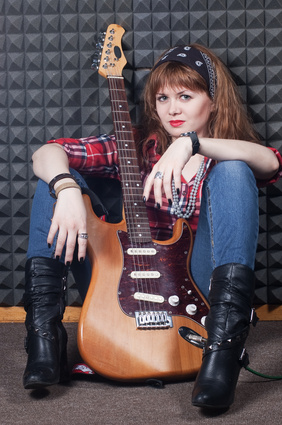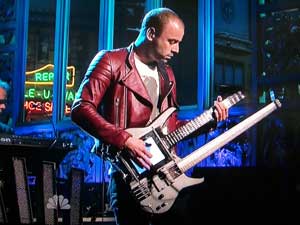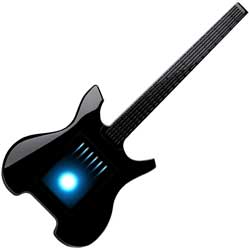 I read an article this morning that was actually about 6 mistakes people make when recording electric guitar. But I found myself mentally defending several of these “mistakes,” remembering or imagining situations where it would be just fine to record electric guitar that way. As usual in the audio recording world, the real answer is it depends.
I read an article this morning that was actually about 6 mistakes people make when recording electric guitar. But I found myself mentally defending several of these “mistakes,” remembering or imagining situations where it would be just fine to record electric guitar that way. As usual in the audio recording world, the real answer is it depends.
In Bjorgvin’s article, he lists 6 things he recommends people try to avoid. One of them is is recording through a DI (direct inject) box using an amp simulator. Hey, that’s my primary method of recording electric guitar. But for me it works. I’m not in a rock band and my albums don’t usually have electric guitar on them. I use it to record demos and covers and other cool things (like my recording of “That Thing You Do!” from the movie of the same name – which you can see here) mostly to teach folks how to do audio recording. I understand what Bjorgvin is saying though. Recording through an amplifier and recording with a mic (or multiple mics) is the traditional way to do it. And if I were in a band and wanted to record the songs I’d been playing live, I’d want to record it just like I played it live – with the same amp on the same settings, etc. So the answer is – it depends.
Another thing on the list is to avoid compressing too much on the way in. Well, I would say that doing anything too much while recording would be properly called a mistake. But sometimes extreme compression is the sound the guitarist is going for. Sure, less compression allows a sound to breathe more. But breathing is not always the desired sound. Tom Scholz, of the group Boston is famous for his extremely compressed electric guitar sound. Again – it depends on the situation.
See Bjorgvin’s list of 6 tips for recording electric guitar here: http://www.audio-issues.com/recording-tips/electric-guitar-recording/
Music Recording
Parallel Compression Tips For Drums
Here is a video showing some tips on how to do a kind of compression when you have drums in your music mix. These tips show something called parallel compression, and it uses Pro Tools. But as is usual with technique videos and articles, you can do this with most any DAW (digital audio workstation) software.
Here is the video:
Drum Hits By Sample Magic For Your Virtual Drumming Pleasure
If your recording software (digital audio workstation or DAW, for short) has MIDI capability (such as Reaper, Pro Tools, Ableton Live, Cubase, etc.), then you can create your own drum kits using single-hit drum samples – virtual drumming fun! You basically have a customizable drum machine in your computer. But the sound of those drums will only be as good as the drum samples played by the MIDI notes. So having a good collection of drum hits is a good thing. Sample Magic recently released Drum Hits, which contains more than 1,300 individual high-quality recordings of kicks, snares, cymbals, percussion, hats, etc.
Find out more here: http://www.samplemagic.com/details/120/drum-hits
Instrument Muse Played On Saturday Night Live – Status Graphite Bass With Kitara?
 Updating this post because I’m watching Late Night With Stephen Colbert on July 20th, 2017. Chris was still playing the same instrument I wrote about back in 2012. Here is what I wrote about it back then.
Updating this post because I’m watching Late Night With Stephen Colbert on July 20th, 2017. Chris was still playing the same instrument I wrote about back in 2012. Here is what I wrote about it back then.
If you saw Muse on Saturday Night Live (Oct 7th, 2012) playing the song, Madness (see video here: http://www.nbc.com/saturday-night-live/video/muse-madness/1419951/), you may have noticed the bass player, Chris Wolstenholme, playing a very strange looking instrument that looked like a bass guitar with a back-lit touch screen which he used to play the notes. It was a combination Misa Kitara Digital Guitar Synth Controller on the top and Status Graphite S2-Classic headless bass guitar put together like a double neck guitar.
Misa (misadigital.com) even has the music video for Madness which shows Chris playing JUST the Misa Kitara (not the mashup with the Status bass). So we know for sure that Misa acknowledges the use of the Kitara on the song. And since Chris has a signature series bass with Status Graphite, we can be pretty darned sure his combo instrument on Saturday Night Live was, in fact, made up of a Misa Kitara and Status Graphite S2. Update in 2017 – apparently the Kitara has been replaced with the “Tri-Bass Digital.”
What the Kitara touchscreen thingy is doing is acting as a combination synthesizer and MIDI controller. There are internal synth sounds that you can select through the synthesizer engine. And then you can apply any number of digital effects to those sounds. The “fretboard” on the neck of the Kitara has no strings, but rather 24 frets, each with a row of 6 buttons, each corresponding to a specific note. The default is that each note is what it would be on a guitar. But you can change those up however you like.
As a MIDI controller, you can connect any MIDI instrument or sound source you have to the Kitara, and trigger them with it, controlling your MIDI gear with the Kitara.
Both Misa and Status Graphite are being very tight-lipped about the dual instrument used by Muse on SNL, probably either because the instrument combo was cobbled together after-market, or is otherwise not available for purchase.

If you want a Kitara for your very own (minus the bass guitar hanging off the bottom;)), you may need to check on eBay for a used one, since they are apparently not being made anymore. For the Misa Tri-Bass Digital, check herefor details or to buy one.
Find out more about Status Graphite here: http://www.status-graphite.com/
And below are some more instruments used by Muse

Release of Amplitube Slash
IK Multimedia just announced the release of their latest iOS product called the Amplitube Slash. As you may have guessed by the reference to Slash, this version of Amplitube includes models of guitar amplifiers and effects pedals used by the famed Guns N Roses guitarist.
IK Multimedia actually worked together with Slash to create this product, so it is as accurate and true to what Slash himself creates as it can possibly be.
If you are not familiar with Amplitube in general, you can see a complete review I did of that product here: www.homebrewaudio.com/amplitube-irig-by-ik-multimedia/ complete with video and audio samples. But to bottom-line it for you, Amplitube is a virtual guitar amplifier that lives in your iPad, iPhone, or iPod Touch. It comes with a piece of hardware, an adapter called the iRIG guitar interface, that plugs into the iOS device and allows you to then plug your guitar into the adapter’s quarter-inch plug. Then you just download the free Amplitube app from the iTunes app store, and rock out. You have a large selection of sounds available and of course you can control the knobs on the amplifier (well, a picture of the amplifier) as you would a real one. Extremely cool!
But now, with the release of Slash, you can expand Amplitube to include his signature sound.
Check it out here:
www.amplitube.com/slash